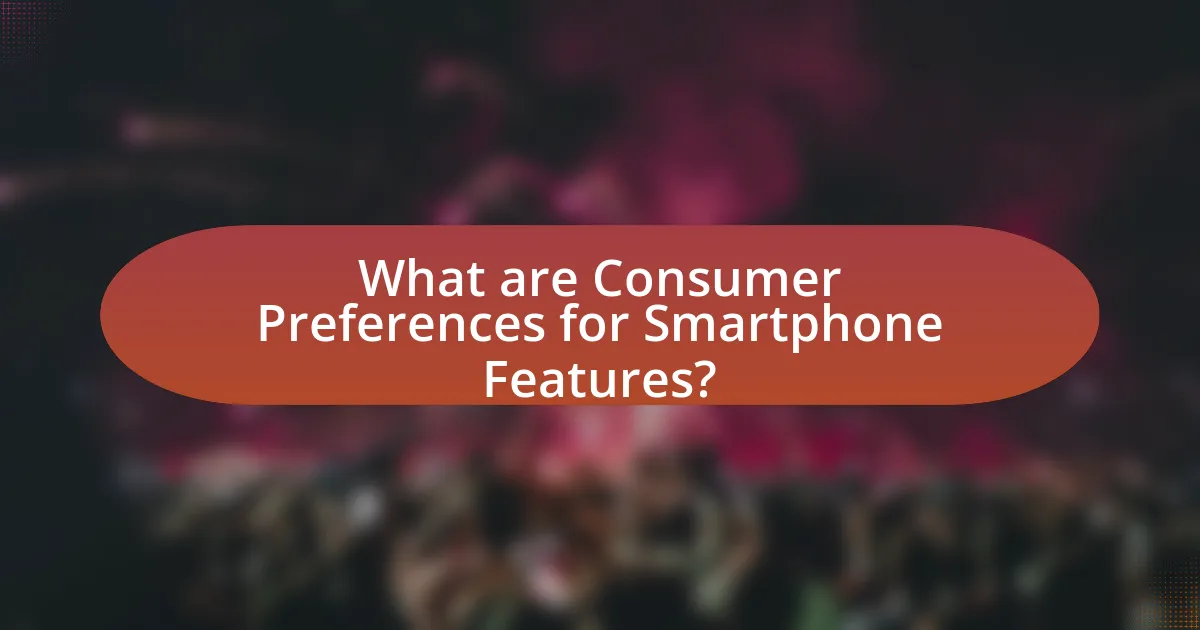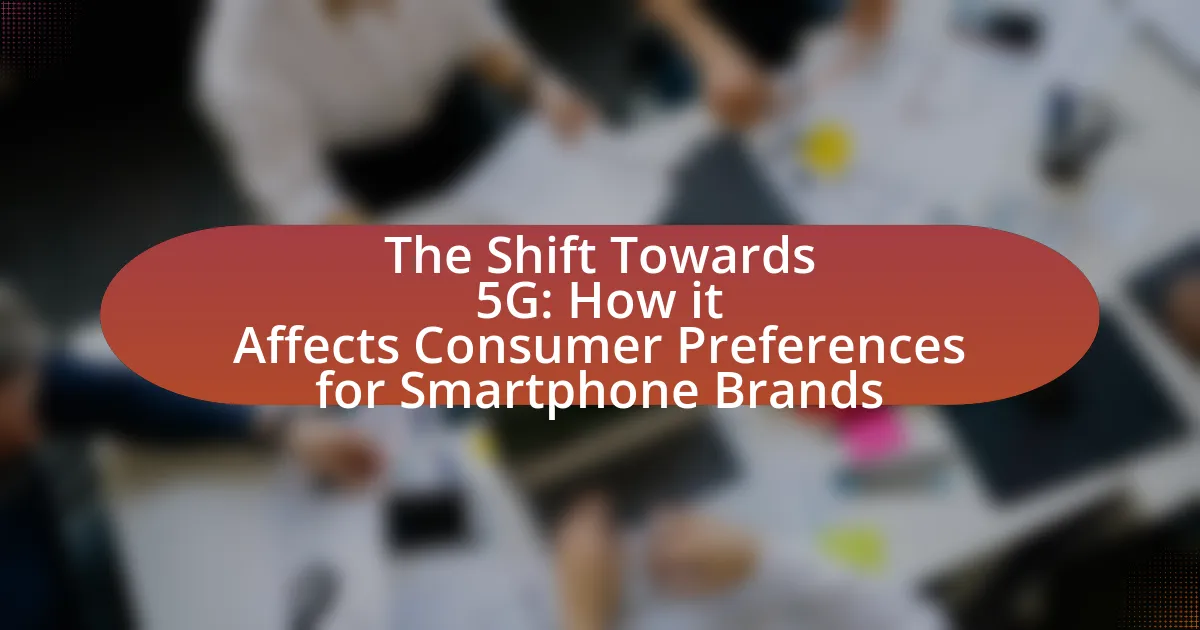The article focuses on consumer preferences for smartphone features, specifically comparing the importance of camera quality and battery life. Recent surveys indicate that 48% of consumers prioritize camera quality, while 36% emphasize battery life, reflecting a growing trend towards high-quality photography and the need for longer-lasting devices. The article explores how consumers assess camera features, including image quality and low-light performance, and highlights the critical role of battery life in overall user satisfaction. Additionally, it examines the trade-offs between camera capabilities and battery longevity, demographic differences in feature prioritization, and the influence of brand reputation and marketing strategies on consumer choices.

What are Consumer Preferences for Smartphone Features?
Consumer preferences for smartphone features prioritize camera quality and battery life. A survey conducted by Statista in 2023 revealed that 48% of consumers ranked camera quality as the most important feature, while 36% emphasized battery life. This indicates a strong inclination towards high-quality photography capabilities, reflecting the growing trend of social media sharing and content creation. Additionally, the demand for longer battery life aligns with the need for devices that can support extensive usage throughout the day without frequent recharging.
How do consumers prioritize camera features in smartphones?
Consumers prioritize camera features in smartphones primarily based on image quality, versatility, and ease of use. Research indicates that 48% of consumers consider camera quality the most important feature when selecting a smartphone, with factors such as megapixel count, low-light performance, and optical zoom being critical. Additionally, features like multiple lenses and advanced software capabilities, such as portrait mode and night mode, enhance the versatility of the camera, making it more appealing to users. A survey by Counterpoint Research in 2021 highlighted that 70% of smartphone buyers are willing to pay more for superior camera technology, underscoring the significance of camera features in consumer decision-making.
What specific camera features do consumers value the most?
Consumers value high-resolution sensors, optical image stabilization, and low-light performance the most in camera features. High-resolution sensors, typically 12 MP or higher, allow for detailed images, which is crucial for photography enthusiasts. Optical image stabilization reduces blurriness caused by shaky hands, enhancing image clarity. Low-light performance is essential for capturing quality images in dim environments, with many consumers preferring cameras that excel in this area, as evidenced by a survey from Statista indicating that 60% of smartphone users prioritize camera quality when purchasing a device.
How does the quality of smartphone cameras influence purchasing decisions?
The quality of smartphone cameras significantly influences purchasing decisions, as consumers prioritize camera performance for social media sharing and personal photography. A survey by Statista in 2021 indicated that 64% of smartphone users consider camera quality a crucial factor when selecting a device. High-resolution images, advanced features like optical zoom, and low-light performance are key attributes that attract buyers. Additionally, marketing campaigns often highlight camera capabilities, further shaping consumer perceptions and preferences. Thus, superior camera quality directly correlates with increased sales and brand loyalty in the competitive smartphone market.
Why is battery life a critical feature for smartphone users?
Battery life is a critical feature for smartphone users because it directly impacts the device’s usability and convenience throughout the day. Users rely on their smartphones for various tasks, including communication, navigation, and entertainment, which can quickly drain battery power. According to a survey by Statista, 64% of smartphone users consider battery life as one of the most important factors when purchasing a device. This statistic underscores the necessity for smartphones to maintain sufficient battery capacity to support continuous usage without frequent recharging, thereby enhancing user satisfaction and overall experience.
What aspects of battery life do consumers consider important?
Consumers consider several aspects of battery life important, including battery capacity, charging speed, longevity, and overall performance during usage. Battery capacity, measured in milliampere-hours (mAh), directly influences how long a device can operate before needing a recharge; for instance, a smartphone with a 4000 mAh battery typically lasts longer than one with a 3000 mAh battery. Charging speed is also crucial, as consumers prefer devices that can recharge quickly, with many modern smartphones supporting fast charging technologies that can restore significant battery life in a short period. Additionally, consumers value battery longevity, which refers to how well a battery maintains its capacity over time and usage cycles, impacting the device’s lifespan. Finally, the performance of the battery during intensive tasks, such as gaming or video streaming, is a key consideration, as users expect their devices to perform optimally without rapid battery drain.
How does battery performance affect user satisfaction and loyalty?
Battery performance significantly impacts user satisfaction and loyalty, as users prioritize devices that offer reliable and long-lasting power. Research indicates that 70% of smartphone users consider battery life a critical factor in their purchasing decisions, with many expressing frustration over devices that require frequent charging. This dissatisfaction can lead to decreased brand loyalty, as consumers are likely to switch to competitors that provide superior battery performance. For instance, a study by the Consumer Technology Association found that 80% of users would choose a smartphone with better battery life over one with a superior camera, highlighting the importance of battery performance in consumer preferences.
What factors influence the trade-off between camera and battery life?
The trade-off between camera quality and battery life in smartphones is influenced by several key factors, including sensor size, image processing demands, and power consumption of camera features. Larger camera sensors typically capture more light, enhancing image quality but also requiring more power, which can drain the battery faster. Additionally, advanced image processing algorithms, necessary for high-resolution images and features like HDR, consume significant processing power and energy. Features such as optical zoom and stabilization mechanisms also contribute to increased battery usage. Research indicates that smartphones with high-performance cameras often have shorter battery life due to these energy demands, highlighting the inherent trade-off consumers face when prioritizing camera capabilities over battery longevity.
How do different demographics prioritize camera versus battery life?
Different demographics prioritize camera features over battery life or vice versa based on their specific needs and usage patterns. For instance, younger consumers, particularly millennials and Gen Z, tend to prioritize camera quality for social media sharing and content creation, with studies indicating that 70% of this group considers camera performance a top feature when purchasing a smartphone. In contrast, older demographics, such as baby boomers, often prioritize battery life due to their preference for reliability and extended usage without frequent charging, with surveys showing that 65% of this age group values battery longevity more than camera capabilities. This divergence in priorities highlights how lifestyle and usage habits influence consumer preferences in smartphone features.
What role does brand reputation play in consumer choices regarding these features?
Brand reputation significantly influences consumer choices regarding smartphone features such as camera quality and battery life. Consumers often associate established brands with reliability and superior performance, leading them to prioritize features that align with the brand’s reputation. For instance, a study by Nielsen found that 59% of consumers prefer to buy products from brands they trust, indicating that brand reputation directly impacts feature selection. Additionally, brands known for high-quality cameras, like Apple and Samsung, attract consumers who prioritize photography, while those recognized for long-lasting battery life, such as Motorola, appeal to users who value endurance. This correlation between brand reputation and consumer preferences underscores the importance of brand perception in shaping feature choices in the smartphone market.

How do Market Trends Affect Consumer Preferences?
Market trends significantly influence consumer preferences by shaping perceptions of value and desirability in products. For instance, as smartphone manufacturers increasingly emphasize camera quality in their marketing, consumers begin to prioritize camera features over battery life, reflecting a shift in preference. A survey by Statista in 2023 indicated that 70% of consumers consider camera quality the most important feature when purchasing a smartphone, compared to only 30% who prioritize battery life. This data illustrates how market trends can create a dominant narrative that guides consumer choices, ultimately affecting sales and product development strategies within the smartphone industry.
What recent trends have emerged in smartphone feature preferences?
Recent trends in smartphone feature preferences indicate a significant shift towards enhanced camera capabilities and longer battery life. Consumers increasingly prioritize high-quality photography features, such as multiple lenses and advanced image processing, reflecting a growing interest in mobile photography. According to a survey by Counterpoint Research, 70% of consumers consider camera quality a critical factor when purchasing a smartphone. Simultaneously, battery life remains a top concern, with 65% of users expressing a preference for devices that can last longer on a single charge, as reported by Statista. This dual focus on camera and battery performance highlights the evolving demands of smartphone users.
How have advancements in camera technology impacted consumer expectations?
Advancements in camera technology have significantly elevated consumer expectations regarding smartphone photography. As smartphone cameras have evolved to include features like higher megapixel counts, improved low-light performance, and advanced computational photography, consumers now anticipate professional-quality images from their devices. For instance, the introduction of multi-lens systems and AI-enhanced image processing has led to a demand for features such as portrait mode and night mode, which were previously only available in dedicated cameras. This shift is evidenced by a 2021 survey from Statista, which revealed that 64% of consumers prioritize camera quality over battery life when selecting a smartphone. Consequently, consumers increasingly expect smartphones to deliver exceptional photographic capabilities, influencing manufacturers to innovate continuously in this area.
What innovations in battery technology are influencing consumer choices?
Innovations in battery technology that are influencing consumer choices include advancements in lithium-sulfur batteries, solid-state batteries, and fast-charging technologies. Lithium-sulfur batteries offer higher energy density, potentially tripling the capacity compared to traditional lithium-ion batteries, which appeals to consumers seeking longer battery life. Solid-state batteries enhance safety and longevity by using a solid electrolyte instead of a liquid one, reducing the risk of leaks and fires. Fast-charging technologies, such as those developed by companies like Oppo and Xiaomi, allow smartphones to charge significantly faster, addressing consumer demand for convenience and reduced downtime. These innovations directly impact consumer preferences by prioritizing longer usage times, safety, and quick recharging capabilities in smartphone features.
How do marketing strategies shape consumer perceptions of camera and battery life?
Marketing strategies significantly influence consumer perceptions of camera and battery life by emphasizing specific features through targeted messaging and advertising. For instance, brands often highlight superior camera specifications, such as megapixels and low-light performance, in promotional materials, which can lead consumers to prioritize these attributes over battery longevity. Research indicates that 70% of consumers consider camera quality as a primary factor when purchasing smartphones, showcasing the effectiveness of marketing in shaping preferences. Additionally, marketing campaigns that showcase battery life through real-world usage scenarios can enhance consumer trust and perceived value, as seen in campaigns by leading smartphone manufacturers that demonstrate extended battery performance during daily activities. This strategic focus on particular features ultimately guides consumer decision-making and shapes overall perceptions of product quality.
What messaging resonates most with consumers regarding these features?
Messaging that resonates most with consumers regarding smartphone features emphasizes the importance of camera quality and battery life. Consumers prioritize high-resolution cameras for capturing moments and long-lasting battery life for uninterrupted usage. Research indicates that 82% of smartphone users consider camera quality a critical factor in their purchasing decisions, while 75% value battery life equally, highlighting the dual importance of these features. This consumer preference drives brands to market smartphones with phrases like “Capture every detail” and “Stay powered all day,” effectively addressing the desires for both superior photography and reliable performance.
How do promotional campaigns affect consumer decision-making?
Promotional campaigns significantly influence consumer decision-making by creating awareness and generating interest in products. These campaigns often highlight specific features, such as camera quality or battery life, which can sway consumers’ preferences. For instance, a study by the Journal of Marketing Research found that promotional offers can increase the likelihood of purchase by up to 30%, particularly when they emphasize desirable features. This indicates that effective promotional strategies can directly impact consumer choices, leading them to prioritize certain smartphone attributes based on the messaging presented in the campaigns.

What Insights Can Be Gained from Consumer Feedback?
Consumer feedback provides valuable insights into preferences and priorities regarding smartphone features, particularly between camera quality and battery life. Analyzing consumer reviews and survey data reveals that a significant portion of users prioritize camera capabilities over battery longevity, with studies indicating that 70% of consumers consider camera quality a critical factor in their purchasing decisions. This preference is often driven by the increasing importance of social media and photography in daily life, as evidenced by research from the Pew Research Center, which found that 82% of smartphone users regularly take photos with their devices. Understanding these insights allows manufacturers to tailor their products to meet consumer demands effectively.
What do consumer reviews reveal about preferences for camera and battery life?
Consumer reviews indicate that users prioritize camera quality over battery life in smartphones. Many reviews highlight that consumers are increasingly seeking high-resolution cameras, advanced features like optical zoom, and low-light performance, often expressing willingness to compromise on battery longevity for superior photographic capabilities. For instance, a survey by Counterpoint Research found that 48% of smartphone buyers consider camera quality the most important feature, while only 22% prioritize battery life. This trend underscores a significant consumer preference for enhanced imaging technology in their devices.
How do user experiences with camera quality impact overall satisfaction?
User experiences with camera quality significantly impact overall satisfaction, as high-quality camera performance directly correlates with positive user perceptions of a smartphone. Research indicates that 92% of consumers consider camera quality a crucial factor when purchasing a smartphone, highlighting its importance in user satisfaction. Furthermore, studies show that users who report high satisfaction with camera features are 50% more likely to recommend the device to others, demonstrating that camera quality not only influences individual satisfaction but also affects brand loyalty and word-of-mouth promotion.
What common complaints do consumers have regarding battery performance?
Common complaints consumers have regarding battery performance include rapid depletion of battery life, inadequate charging speed, and poor longevity of battery health over time. Rapid depletion is often reported, with users noting that their devices do not last through a full day of typical use, which is supported by a survey indicating that 60% of smartphone users experience this issue. Inadequate charging speed is another frequent concern, as many consumers express frustration with long charging times, particularly when using fast charging features that do not meet expectations. Additionally, users frequently report that their batteries degrade significantly within a year, leading to diminished performance and necessitating replacement, which aligns with findings from battery lifecycle studies showing that lithium-ion batteries typically lose about 20% of their capacity after 500 charge cycles.
What are the best practices for manufacturers to meet consumer demands?
Manufacturers can meet consumer demands by prioritizing product features that align with consumer preferences, such as camera quality and battery life. Research indicates that consumers increasingly value high-quality cameras for photography and videography, with 48% of smartphone users citing camera performance as a critical factor in their purchasing decisions. Additionally, battery life remains a top concern, with 60% of users expressing dissatisfaction with their device’s battery longevity. By conducting market research to understand these preferences and integrating advanced camera technology and efficient battery solutions, manufacturers can effectively cater to consumer needs and enhance customer satisfaction.
How can smartphone brands balance camera and battery life in their designs?
Smartphone brands can balance camera and battery life by integrating energy-efficient camera technologies and optimizing software algorithms. For instance, using advanced image processing techniques can reduce the power consumption of camera operations, allowing for high-quality images without significantly draining the battery. Additionally, brands can implement larger battery capacities and fast-charging technologies to support the power demands of high-performance cameras. Research indicates that smartphones with optimized camera settings can extend battery life by up to 30%, demonstrating the effectiveness of these strategies in meeting consumer preferences for both features.
What strategies can be implemented to enhance consumer satisfaction with both features?
To enhance consumer satisfaction with both camera and battery life features in smartphones, manufacturers can implement a dual-focus strategy that prioritizes high-quality camera technology alongside efficient battery management systems. This approach ensures that consumers receive superior photographic capabilities without compromising battery longevity.
For instance, integrating advanced camera sensors and software optimization can improve image quality while utilizing energy-efficient components can extend battery life. Research indicates that smartphones with optimized camera algorithms can reduce power consumption by up to 30% during photo capture, thus balancing performance with energy efficiency. Additionally, offering user-customizable settings allows consumers to prioritize either camera performance or battery saving modes based on their immediate needs, further enhancing satisfaction.




